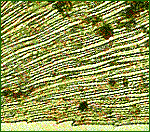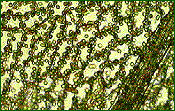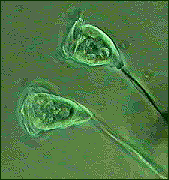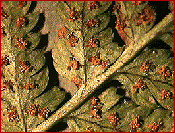![]() December
December
 This month's features:
This month's features:
- important notes on collecting.
- non-flowering plants are beautiful too!
- pond dipping I: two protozoa that are easy to
find
- nature's pepper pots
- suggested reading
- practical courses
Now that the autumn colours are fading, you may be forgiven for thinking that the countryside is looking somewhat stark, and that there is little to excite the microscopist.
On the contrary, there is plenty of interest, so join me in this months' walk to collect specimens for study during those long winter evenings.
Before you put your boots on, please read the important notes on collecting.
 Now that the vegetation has died back, and there
are no wild flowers to admire, the non-flowering plants are worth
a closer look. Some are very obvious and attractive such as the
ferns and fruiting bodies of the larger fungi, but the mosses,
liverworts and lichens reveal plenty of interest in close up.
Now that the vegetation has died back, and there
are no wild flowers to admire, the non-flowering plants are worth
a closer look. Some are very obvious and attractive such as the
ferns and fruiting bodies of the larger fungi, but the mosses,
liverworts and lichens reveal plenty of interest in close up.
This month we will just provide a gentle introduction to them particularly the mosses, and point out where you may find them. In the next few winter months we will look at some of the individual groups in more detail.
There isn't space to decribe the differences between these organisms, but have a look at suggested reading. Also keep an eye on our Articles section. For the time being, if you are unfamiliar with identifying the plants, you can still admire them and learn to spot different species just by their colour, leaf arrangement and habitat.
My advice last month about always carrying a hand lens will be well-heeded this month. Try and pick a local walk where it will be damp - one where there is a stream valley, stone walls facing north, dense woodland etc.
Walk slowly and stare at your feet! Start examining with the lens those patches of green at the bases of trees, amongst the leaf litter and clinging to stone walls. Some species prefer calcium-rich habitats such as concrete slabs and the mortar in walls. Examine the tops of wet tree stumps, which often have a superb growth of mosses. If near a stream, look at the bank just above the water level. There will be a higher humidity maintained here and should provide a wealth of mosses and perhaps liverworts.
 Much of the enjoyment of these plants can be
experienced during the walk. Hold a stem of a moss up to the
light, and examine under the lens. Some moss leaves have delicate
serrated edges even though the leaf is barely 2mm long. Others
have a long fine point to the leaf tips. There are a wide variety
of leaf shapes too. The leaves are often only a single cell
thick, so with a good hand lens you may be able to make out the
single cells if a leaf is inspected against the light. Two
examples of the cellular structure of moss leaves are shown to
the left and at the head of this section.
Much of the enjoyment of these plants can be
experienced during the walk. Hold a stem of a moss up to the
light, and examine under the lens. Some moss leaves have delicate
serrated edges even though the leaf is barely 2mm long. Others
have a long fine point to the leaf tips. There are a wide variety
of leaf shapes too. The leaves are often only a single cell
thick, so with a good hand lens you may be able to make out the
single cells if a leaf is inspected against the light. Two
examples of the cellular structure of moss leaves are shown to
the left and at the head of this section.
If you are lucky enough to be in an area with natural springs, calcareous flushes or water seeping out of rocks, then these are the places to look! The constant damp conditions should provide a wealth of interesting plants. But these habitats may be scarce - so admire the plants in situ (even if it means getting your knees wet!) and please don't damage the habitat.
Take a few small samples of the commonest mosses back with you in small plastic bags. Mosses can also be stored in paper envelopes and allowed to dry before future study. Dehydrated mosses recover well in a dish of water and usually retain their colour.
Examine the moist mosses under a low powered stereo and admire their elegance of form. Some mosses form compact rounded humps whereas others adopt a branching tree-like structure... more about this in future.
With a pair of forceps carefully remove a single leaf from each moss, mount in water under a cover-glass and examine under a high powered microscope at various magnifications. The cellular structure, which is an important diagnostic feature in identification, is clearly seen.
You may notice under a stereo microscope when you immerse the moss in water, that there are aquatic animals present. There will be an article on the animal life of mosses very soon!
 At this time of year when ponds start to fill with
decaying vegetation, there can be an increase in the bacterial
population. This in turn can cause an increase in the protozoa
that feed on them.
At this time of year when ponds start to fill with
decaying vegetation, there can be an increase in the bacterial
population. This in turn can cause an increase in the protozoa
that feed on them.
So if you have a pond or small lake on your local walk, it is worth taking a few samples to examine under the microscope. There is so much of interest that can be found in freshwater, that we will be regularly dipping into the ponds and streams throughout the year.
No special equipment is required for collecting protozoa. The two genera of interest to us this month are commonly found attached to plants ie the Stentor and Vorticella. Collect a few short stems of water weed, such as Potamogeton, Irises, decaying leaf stalks and other decaying plant debris and store in a water-tight jar in some pond water until you get back home.
Empty out the pond water and plant debris into a shallow glass dish and allow to settle. Inspect carefully with a hand lens. Vorticella are colonial and may be seen as a speck of grey 'jelly' attached to a plant stem. If disturbed the whole colony may contract to a smaller blob. Vorticella are bell-shaped organisms on a contractile stalk (the figure at the top of this section). They have a growth of cilia (vibrating hairs) around the rim of the open bell which they use to generate a current of water to draw food to it's gullet.
If you find a colony, mount the stem in water under a cover slip supported off the slide by about 0.5mm. Inspect under medium powers on a high power microscope and observe how the Vorticella behave.
Vorticella are also epizooic, that is they attach themselves to larger animal organisms such as crustacea.
The Stentor is the elephant of the protozoa world, it is often up to 2mm long and can dwarf some of the smaller multicellular creatures. The author has written a separate article with photos on how to find and study this protozoa, so

 Nature's what?! Well, it's how I like to
think of the way the non-flowering plants such as ferns and
mosses disperse their spores. Although it's getting a little late
in the season, get in the habit of turning over the leaves of
ferns on your walks. The mature specimens should show the remains
of the sori, which is a cluster of sporangia ie where the spores
develop. The right hand figure show the sori on the underside of
a typical fern leaf. The arrangement of the sori are a diagnostic
feature when identifying a fern. They are interesting to view
under a hand lens or low power stereo microscope.
Nature's what?! Well, it's how I like to
think of the way the non-flowering plants such as ferns and
mosses disperse their spores. Although it's getting a little late
in the season, get in the habit of turning over the leaves of
ferns on your walks. The mature specimens should show the remains
of the sori, which is a cluster of sporangia ie where the spores
develop. The right hand figure show the sori on the underside of
a typical fern leaf. The arrangement of the sori are a diagnostic
feature when identifying a fern. They are interesting to view
under a hand lens or low power stereo microscope.
The real claim to the title nature's pepper pot should go to the mosses. The spore capsule of a typical moss is born on a stalk, the seta, and is shown in the left hand figure. When the capsule is ripe the minute spores are literally shaken out of the 'pot' by the wind through minute perforation s in the spore lid. Many of the mosses you see on your walk should have spore capsules, not all of them ripe. Look at these capsules through a hand lens, the pepper pot lid should just be visible. Take a few back to examine under a stereo microscope.
Natural History Book Services
A comprehensive on-line service with search facilities.
Although the naturalist is spoilt for choice with books on wild
flowers and trees, books dealing with the non-flowering plants
are few and are often technical monographs. Here are a few the
author has found useful, but inevitably they are orientated
towards the UK or Europe.
1) The Oxford Book of Flowerless Plants by F H Brightman. Peerage Books, London 1985. ISBN 0 907408 46X. 208 pages.
I believe this book is out of print, but it is a real gem, so keep an eye out for it in either the secondhand or remaindered bookshops. Beautiful paintings of fungi, ferns, seaweeds, mosses and liverworts with short descriptions. Arranged by habitat, which is a useful way of introducing these plants.
2) Collins Guide to the Ferns Mosses and Lichens of Britain
and Northern Europe by H M Jahns. Collins, London 1980. ISBN
0 00 219254 3. 272 pages.
Collins have a good reputation for producing natural history field guides. There are photographs of most of the species covered, but it is not easy identifying a moss (for example) just from a photograph. The guide could have benefited from some line drawings of the leaf structures. There are keys at the front which should help in identifying a plant to the genus.
3) Grasses, Ferns, Mosses and Lichens of Great Britain by
Phillips. Published by Pan 1980. 224 pages.
A large format book of high quality photos of each selected specimen. It suffers from trying to cover too many groups in one volume (grasses alone deserve their own volume) and therefore only covers a selection of the commonest species. Worth browsing through if it's in your library to appreciate the differences in form of the non-flowering plants.
4) British Mosses and Liverworts by E V Watson. Cambridge University Press, 1981 3rd edition. 519 pages.
This is the book for the UK naturalist wishing to really
get to grips with the bryophytes. The book looks daunting, but
after learning a little terminology, the keys are straightforward
and the drawings of each species are a delight. Somewhat
expensive so try your library first! Softback version ca
£30.
5) A Beginners Guide to the Collection, Isolation, Cultivation and Identification of Freshwater Protozoa by B J Finlay, A Rogerson and A J Cowling. Published by the Freshwater Biological Association, The Ferry House, Ambleside, UK, 1988. (78 pages) ISBN 1 871105 03 X.
If you would really like to get to grips with one or more of the plant groups described above, why not go on a weekend course?
In the UK, the Field Studies Council have residential centres situated in some of Britain's most beautiful scenery, where you can be instructed by an expert at an easy pace. The centres are fully equipped with microscopes and field guides, so this is a very enjoyable way of learning about these plants. A word of warning, once you have attended one course, you may (like me) be smitten by the bug and attend a course on something else next year!
This is the time of year when non-flowering plant courses are often held, so why not contact them and see whether there are any places free?
Contact address: Field Studies Council, Preston Montford, Shrewsbury, Shropshire SY4 1HW. Tel 01743 850674
If you don't live in the UK, check with your local library, college or tourist office about evening classes, residential courses etc.
All images by the author.
Fractal fern created using Fractint for Windows version 17.01 from the Stone Soup Group.
All images captured from still frames of VHS videos or direct from CCD camera using a Creative Video Spigot capture card.
Primary microscope magnifications in the range 60-400x before projection into a Panasonic WV-CL350 video camera.
Phase contrast image of Vorticella taken using Cooke, Troughton and Simms phase contrast microscope. Other microscope images taken using Russian Biolam microscope with achromatic objectives.
Macro photos using 50mm SLR lens and extension tubes mounted on CCD camera.
Image manipulation using Photostyler software.
Comments to: Dave Walker